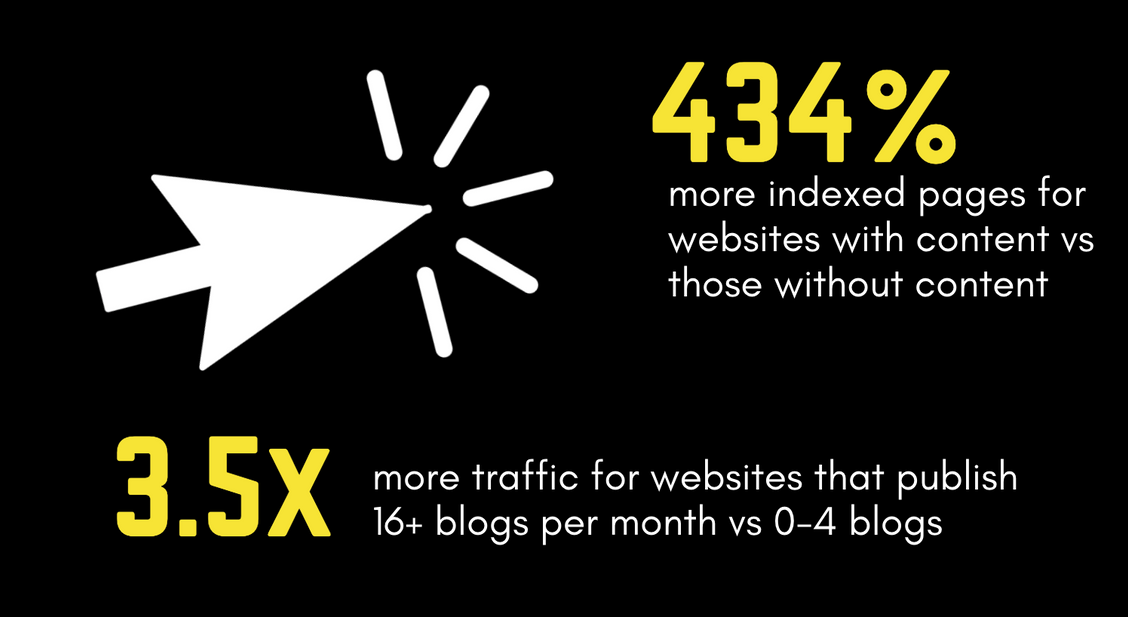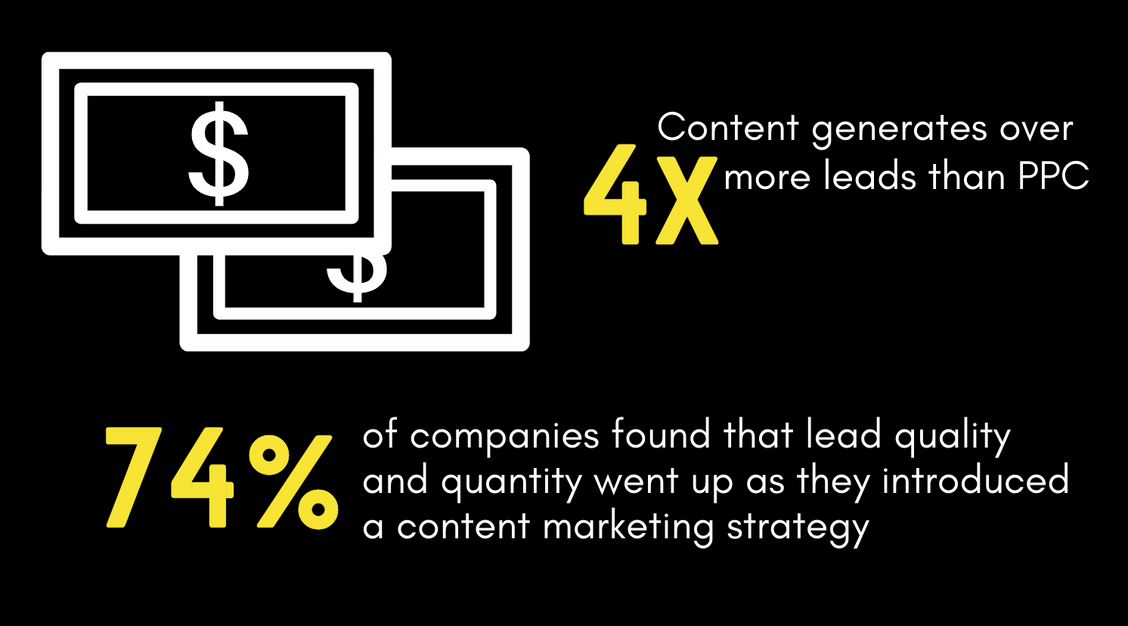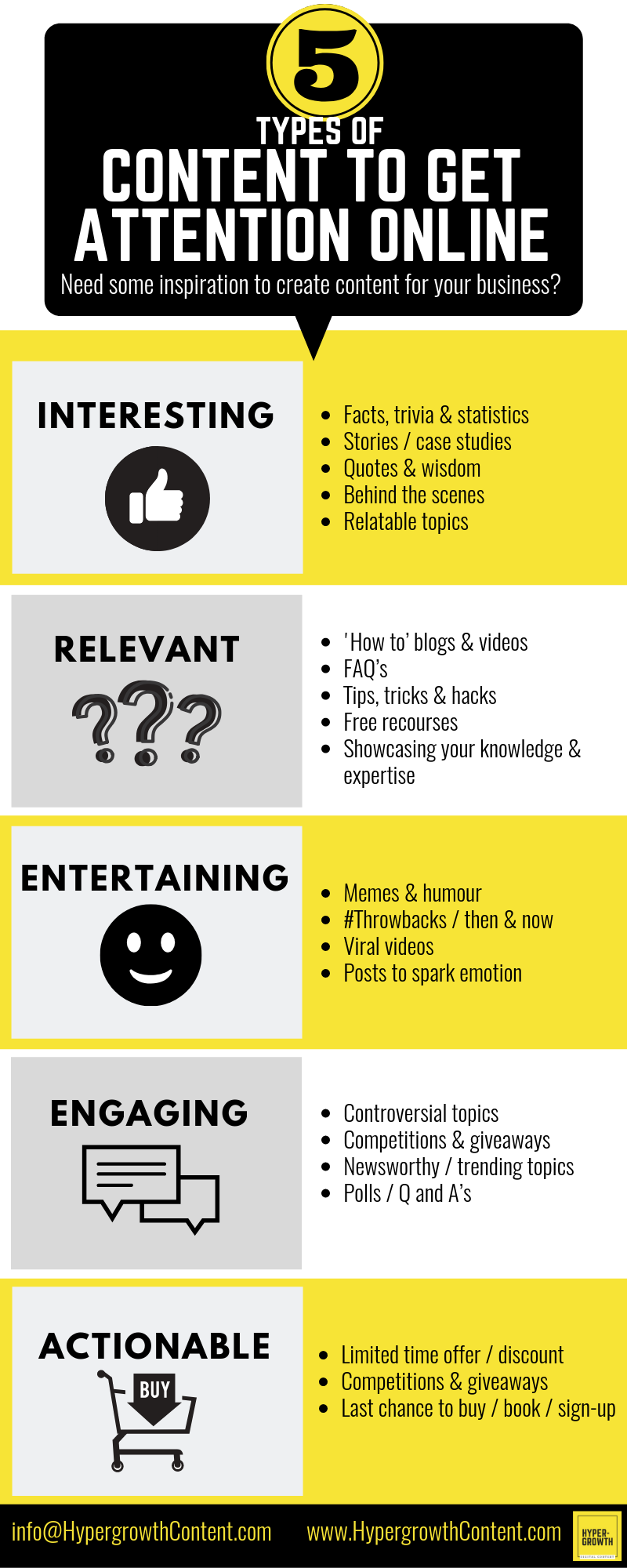This guide includes:
- Introduction
- Section 1: Why use content marketing?
- Section 2: Content marketing vs advertising
- Section 3: How to use content marketing in business
- Section 4: How to get the most out of content marketing
Read time: 12mins (ish)
INTRODUCTION
If you’re thinking about using content marketing in your business, great, you’ve come to the right place. This guide will tell you everything you need to know about content marketing as well as the steps you can take to start implementing it in your marketing strategy.
Content marketing is a relatively new type of marketing that provides media-type content to your customers, clients or social audience in exchange for their attention. Through gaining your audiences’ attention, you can build a long-lasting relationship which can lead to future sales.
Content marketing should always aim to provide value to the audience in at least one of three ways: educational, informative or entertaining. In all cases, the content you create for these purposes should be free and easily accessible to the user.
So, why would a business go to the effort of creating free content for their audience? Read on to find out…

SECTION 1
Why use content marketing?
Creating quality content for your business on a regular basis means you’re likely to see significant growth in the following areas.
1. Increased organic SEO and website traffic
Content marketing is still one of the most effective ways to generate organic leads. As you add more quality content to your website, the more visible you become to search engines (like Google) and this will increase your page rank and SEO score making it easier for customers to find you.
Adding content to your website consistently can significantly boost your brands online visibility and drive more potential customers to your product/service.

2. Increased customer trust
Naturally, customers want to buy from a business they trust and content marketing is a great way to build brand authority in your industry.
Even if customers don’t buy from you straight away, creating content that perceives you as the expert in your field will mean you’re more likely to stick in the customers’ mind and make them think of you when they’re ready to buy.
3. Increased engagement
Content isn’t just about what you create for your website, it’s anything your business puts out on social media or third party sites, too. Sharing content that is of interest or entertaining to the user will usually result in your audience clicking the link to read or watch more, and (or) sharing the content with their friends.
The higher the engagement level for your content, the more people will see it and the more people will know about your business.

4. Increased sales
Every business relies on sales to succeed and the ultimate goal of any marketing activity is to sell more of your product or service. Whether customers buy from you instantly after viewing your content or come back later, strategic content can have a powerful effect on your business’ bottom line.

SECTION 2
Content marketing vs traditional advertising
Traditional adverts, such as billboards, website pop-ups, magazine ads, T.V. commercials, radio ads, etc rely on companies to create ad content that interrupts the viewer as they’re doing something else, such as watching a show or reading a blog post.
Traditional ads rely on good placement, clever wording, and exceptional creativity to capture customers attention for a brief period of time in the hope that they either click on the advert or contact the business. However, the majority of the time, the ads don’t provide any value to the viewer.
No one likes being harassed by adverts and this is where content marketing is great as businesses can reach potential customers without interrupting them but also providing them with value.
Source: Tom Fishburne
With content marketing, instead of developing ads that interrupt customers, companies can create interesting, informative or entertaining content that results in the user either buying with the company or coming back time and time again. Content has the power to create long-term customers through building an engaging relationship.
Effective content marketing should provide your audience with what they want to read, watch or listen to – rather than bombarding them with adverts.
4 Advantages of Content Marketing over Traditional Advertising
- Content marketing provides value to customers, traditional ads do not.
- Content marketing can attract customers for free, adverts cost money.
- Content gets organically shared, adverts do not.
- Content marketing improves SEO, adverts do not.
FACT: Content marketing generates over 4x more leads than PPC
SECTION 3
How to use content marketing in business
Creating content without a plan is like driving without any sense of direction. You may get there in the end, but you’re sure to take a few wrong turns along the way. Like any marketing activity, having a clear strategy is crucial to get the results you want.
These are the biggest content marketing challenges:
- 30% of businesses haven’t got a documented content strategy
- 64% of marketers need help on building a better content strategy
- 60% of marketers find it difficult to produce content consistently
Before you start creating content for your business, there’s a few things you need to keep in mind to get the best results. Consider these questions when creating your content marketing strategy:
1. What are your customers interested in?
The main purpose of content is to provide value and as we mentioned before, content should be interesting, educational or entertaining.
Find out what your customers are into and create content around that. Is there a common question your customers ask before buying your product? If so, create a blog post about it. Or, is there a general interest that all your customers have in common? For example, if your business sells sports cars, you could create some cool content based on the best sports cars on the market.
2. What is the purpose of the content?
Why are you creating content and what do you want the outcome of it to be?
Do you want the user to take any specific action before or after viewing your content, such as, sign up for your newsletter, buy your product, book your service? Or, do you want to create engaging or valuable content that builds your brand message and keeps people coming back again and again?
Whatever your reason for creating content, make sure it’s easy and clear for your audience to act on what you want them to do.
3. Consider your competition
Keep an eye on your competitors and what they’re creating. This not only gives you ideas for content that you can create but also what not to create.
You can do this by seeing what their users engage with on social media. If their content is getting lots of likes, comments or shares online, you should consider creating something similar.
4. Decide what content to create and how you’ll create it
Most successful content marketing strategies rely on having a central core of content, such as a website blog which can then be repurposed and shared on other sites and social media.
When creating content, consider these ways to get the most angagement or attention from your content:

A blog should be an essential part of your content marketing strategy, and the posts within it should be actionable, valuable, and shareable. But a blog post isn’t all you can create and there are many different formats of content that your audience may be interested in.
Different content formats:
- Blog posts
Blogs are a great way to boost brand authority by providing readers with interesting facts and entertainment on your website or social media channels. They can also increase your websites’ SEO score and help your customers find you online easier.
- Infographics
Using a visual representation of information or data can capture your audiences’ attention and make an impact when words alone can’t. Take the crucial snippets of information and stats and then compile them into easy-to-absorb infographics.
- Guides
Guides are extended, in-depth blogs that provide immense value for your audience.
They’re a great way to build customer trust and demonstrate your industry knowledge.
- E-books
These are mini digital books to provide insight into an industry or topic and provide your customers with, you guessed it, value. Most E-books will encourage the client / customer to take some sort of further action such as buying your product/service.
- Whitepapers
A persuasive, authoritative, in-depth report on a specific topic that presents a problem and provides a solution in your industry. These are particularly useful for the financial, politicial and government industries.
- Videos
Video is set to continue growing for years to come. Posting videos will increase your chance of getting your message across to customers in a clear and concise way. Remember to always add text to your videos so they can be watched and understood even if the device is on mute.
- Social posts
Platforms like Facebook and Instagram have made it easy for brands to post content straight to their profile page. While website content is important, social media is the best way to reach your audience and get your content out there. Social content can be anything from a simple status update, posting blog post from your website, posting an eye-catching infographic, or sharing videos, memes and quotes.
Any type of visual is great to attract attention in social media news feeds. Always make sure your content is tailored to the social channel you are posting it on in order to get the best response.
It’s a good idea to create a variety of content to begin with in order to gage what your audience responds to the best. Content isn’t just limited to just your website and any content you publish online should link back to your website.
Other ways you can create content to increase brand awareness:
- Guest blogging / contributing on third party websites
- Creating or collaborating on Youtube videos
- Creating or speaking on podcasts


5. Repurpose your content
Creating a constant stream of new content can be challenging. Sometimes it’s hard to think of fresh new ideas, especially if you’re not the most creative person. And other times you simply do not have the time to come up with something new. This is where repurposing content comes in.
What is repurposing content?
Repurposing content consists of taking old content you have created and re-using it in a different way to create a new piece of content. This is a great way to freshen up your content bank without spending a lot of time brainstorming, researching and creating something from scratch.
As well as saving time, repurposing means you get more value out of older pieces of content and it’s also a powerful way to enhance your websites’ SEO.
However, repurposing content is more than just a quick edit and swapping around similar words. It’s about turning the content into something that is vastly different to what it was before, while keeping the same theme and saving you a lot of time.
When you repurpose a piece of content, you’re doing one or both of the following:
- changing the format of the content
- changing the target audience for the content.

Examples of repurposing content:
- Taking an existing blog post and making it relevant to a different buyer persona or target market (new target audience).
- Taking an old factual blog and using the statistics / data to create an infographic (new format).
- Taking an e-book aimed at SME’s and rewording and restructuring it throughout to apply to start-ups (new target audience).
- Taking a social media post and recreating it on another social media channel (new content format).
- Taking an old piece of content and selecting key snippets to share on social media (new content format).
What repurposing content is not:
- ‘News-jacking’ – taking one or more news articles created by someone else and spinning them into a blog for your own audience.
- Taking a guide and simply changing all of the references to target another audience, such as swapping ‘Small Business’ with ‘Start-ups’.
- Re-sharing an old piece of content on social media with a new description or title.
- Taking someone else’s work and editing it slightly to pass it off as your own (plagiarism).
6. Establish your content KPI’s
Like any marketing activity, you need to be able to measure your activity and analyse if the content is proving to be beneficial to your business. To do this, decide what your key performance indicators (KPI’s) are. Some common content KPI’s are:
- Increased engagement (more likes, shares, comments)
- Increased traffic / phone calls
- Increased purchases / bookings / orders / sign-ups
7. Create a content calendar
Creating and publishing content aimlessly without a plan is like throwing mud at the wall and hoping something sticks. Everything you create should have a purpose and creating a content calendar is a great way to organise your ideas and creations so that you have a constant flow to keep your audience coming back again and again.
A content calendar should be used to plan the topics and types of content you plan to create on specific dates. However, if you outsource your content to an agency or freelancer, they’ll do all of this for you.
The key to an effective content marketing is to provide valuable, quality content on a consistent basis. Create a clear content plan considering all of the steps above, and you’ll be well on your to more engagement, traffic and sales.
There are many tools available to help you create your content calendar, such as ContentCal, or you can simply go ‘old-skool’ with an excel spreadsheet.
ContentCal allows you to visually schedule your content
SECTION 4
How to get the most out of content marketing
Like any marketing activity, it’s crucial to get results from your efforts, otherwise, what’s the point?
When it comes to content marketing, businesses need to proactively monitor the effectiveness of the content they’re creating and adjust their strategy accordingly.
You can measure the performance of your content by analysing the KPI’s you set.
- Engagement: How many shares, likes, comments did the content generate?
- Traffic / interest: Did your website traffic increase or did the phone start ringing as a result of the content?
- Sales: Did you get more bookings, orders or signs-ups as a result of the content?
It’s a good idea to create a variety of content to begin with in order to gage what your audience responds to the best. Then later on you can assess which types of content perform the best and create more of those types.
However…
Content marketing takes time. In order to get the lasting benefits of content, businesses need to be willing to invest in a long-term content strategy. That’s not to say a few quick wins can’t be achieved, though. Any business that starts creating great content will see an increase in interest and an improvement in sales from the get-go.
Experts suggest 3-6 months is a reasonable period of time to start seeing solid results. While this may seem like a long time, content marketing also provides long-term results unlike any other form of marketing.

Consider outsourcing your content
If your business doesn’t have the time or recourses to create content on a regular basis, outsourcing it to an expert will ensure a stream of quality content is created frequently.
Outsourcing your content means your business can:
1. Save time: the agency will do all of the brainstorming and creation for you, allowing you and your team to focus on other areas of the business.
2. Save money: outsourcing content to an agency or freelancer is usually cheaper than hiring a full-time in-house writer. The agency will often charge per piece or per project, meaning they work fast to deliver the job on time. A full-time writer will often take longer to create content as there is no sense of urgency to bill the client and they have all day to get the work done. Outsourcing content means you only have to pay for the content you need, when you need it.
3. Benefit from quality expertise: Let’s face it, not everyone is a great writer or creator. By outsourcing your content to an expert, you hand over all responsibility to create great content, so you don’t have to worry about doing it yourself.


